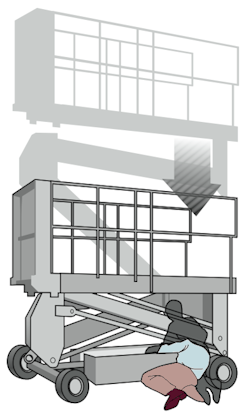Real-Life Scenario
Hazardous Energy in the Workplace Can Kill
The son of the owner of a commercial drywall construction company in Oregon, who was also an employee of the company, was preparing an aerial lift for a job and had replaced two battery terminals. He raised the aerial boom and was reaching toward the battery compartment across the metal enclosure that houses the lift's toggle controls when the boom dropped and pinned him to the control panel. His father discovered him and summoned emergency responders, but he died at the site.
Oregon OSHA Investigation Findings
- The employee did not use lockout procedures while he was working on the lift and did not block the boom to prevent it from dropping.
- The lift's emergency valve, hydraulic hoses and fittings, and electrical wiring were inspected after the accident and were not defective; however, the on/off key switch had been bypassed so that the operator could use the toggle switches without using the key.
- The battery charging system was missing a fuse that would stop the system from charging, and the spring-loaded toggle switches that controlled the boom did not have guards to prevent accidental contact.
- The owner had not reviewed the lift's instruction manual with the victim or other company employees.
The accident resulted in the following violations:
- OSHA Standard 1910.147(c)(4) - The employer did not develop, document, and require employees to use lockout procedures to control hazardous energy during maintenance work.
- Oregon Standard 437-001-0760 - The employer failed to ensure that employees did not remove or tamper with required safety devices.

